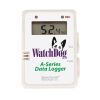HOBO MX Temperature Data Logger
Features
- Set up and offload loggers wirelessly from your mobile device or Windows computer
- Splash-proof design enables use in damp environments and spray-down applications
- Visual alarms on the logger display and mobile app keep you notified of problems
- Expedited repair and warranty service
- Lifetime technical support
- More
Overview
The Onset HOBO MX100 is a low-cost, splash-proof, Bluetooth-enabled data logger that measures and transmits temperature data wirelessly to mobile devices or Windows computers. The HOBO MX100 data logger requires a compatible mobile device or Windows computer running the HOBOconnect app.
Deployment
Ideal for a range of indoor monitoring applications, this self-contained wireless data logger lets you configure it and access temperature data at any time when within a 100-foot range, with no dedicated equipment beyond a mobile device or Windows computer running the HOBOconnect app.
|
Temperature Sensor |
|
|
Range |
-30° to 70°C (-22° to 158°F) |
|
Accuracy |
±1.0°C from -30° to -5°C (±1.8°F from -22° to 23°F) |
|
Resolution |
0.04°C (0.072°F) |
|
Drift |
<0.01°C (0.018°F) per year |
|
Response Time |
6 minutes typical to 90% in open air moving 1 m/s, unmounted |
|
Logger |
|
|
Logger Operating Range |
-30° to 70°C (-22° to 158°F) |
|
Radio Power |
1 mW (0 dBm) |
|
Transmission Range |
Approximately 30.5 m (100 ft) line-of-sight |
|
Wireless Data Standard |
Bluetooth Smart (Bluetooth Low Energy) |
|
Logging Rate |
1 second to 18 hours |
|
Time Accuracy |
± 1 minute per month at 25°C (77°F) |
|
Battery |
CR2450 3V lithium, not replaceable |
|
Battery Life |
1 year, typical with logging interval of 1 minute and Power Saving Mode disabled; 2 years, typical with logging interval of 1 minute and Power Saving Mode enabled. Faster logging intervals, remaining connected with the app, excessive downloads, and paging may impact battery life. |
|
Memory |
30,000 Measurements |
|
Full Memory Download Time |
Approximately 30 seconds; may take longer the farther the device is from the logger |
|
Dimensions |
6.9 x 4.5 x 1.1 cm (2.71 x 1.76 x 0.42 inches) |
|
Weight |
25.5 g (0.90 oz) |
|
Environmental Rating |
IP67 |
In The News
From Paddles to Phytoplankton: Studying Vermont’s Wildest Lakes
For six months of the year, Rachel Cray, a third-year PhD student at the Vermont Limnology Laboratory at the University of Vermont, lives between a microscope and her laptop, running data. For the other six months, she is hiking and canoeing four of Vermont’s lakes, collecting bi-weekly water samples. Cray studies algal phenology across four lakes in Vermont, US, that have low anthropogenic stress—or in other words, are very remote. Funded by the National Science Foundation Career Award to Dr. Mindy Morales, the lakes Cray researches part of the Vermont Sentinel Lakes Program, which studies 13 lakes in the area and, in turn, feeds into the Regional Monitoring Network, which operates in the Northeast and Midwest US.
Read MoreReimagining Water Filtration: How Monitoring and Science Enhance FloWater Filtration Systems
Over 50% of Americans think their tap water is unsafe , according to the Environmental Working Group (EWG). Other recent surveys have found that number to be as high as 70% of persons surveyed. Whether due to increased public awareness of water quality issues or confusion about how municipal water sources are regulated, there is a clear distrust of tap water in the United States. According to industry expert Rich Razgaitis, CEO and co-founder of the water purification company FloWater, this issue creates a damaging cycle. Razgaitis explained that the health and environmental problems associated with contaminated water aren’t the only issues. As people become increasingly aware that some tap water is unsafe, they resort to bottled water.
Read MoreMonitoring New Hampshire’s Aquatic Ecosystems: Continuous Data Collection in the Lamprey River Watershed
New Hampshire’s aquatic ecosystems provide a range of ecosystem services to the state and region. Resources and services like clean water, carbon storage, climate regulation, nutrient regulation, and opportunities for recreation all depend on New Hampshire’s aquatic ecosystems remaining healthy. Jody Potter, an analytical instrumentation scientist at the University of New Hampshire (UNH), is studying these aquatic ecosystems in hopes of developing an improved understanding of ecosystem services and their interactions with climate change, climate variability, and land use changes. [caption id="attachment_39799" align="alignnone" width="940"] Aquatic sensors in the Merrimack River in Bedford, NH, with I-293 in the background.
Read More










